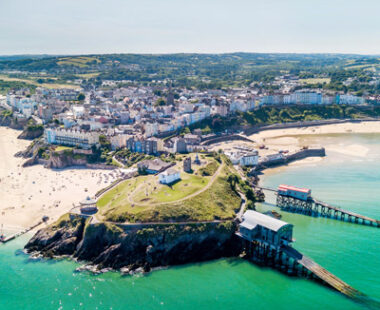The history of Pembrokeshire is as rich and dramatic as its landscape. It can be traced as far back as the prehistoric era and is intrinsically linked to its coastline – whether to the early spread of Christianity or Viking invasions.
St David
Pembrokeshire has strong links to Wales’ patron saint, David. The building of St Davids Cathedral began in around 1180 but evidence of worship at the site stretches back centuries further. St David is said to have founded a monastery at the current cathedral site in 500AD and it has been attracting worshippers, and admirers, ever since. You can learn more about its fascinating history on a guided tour.

The origins of St Davids Cathedral can be traced back to 500AD
You’ll discover Wales’ only cathedral library in situ and its 7,000 books, some of which date back to the 16th century. At the Gatehouse, find original artefacts from the cathedral’s past, including a medieval bell, door carvings and historically significant gravestones. Coincide your visit with a service to be in with a chance of hearing the cathedral’s renowned choir.
From here, head to the remains of St Davids Bishop’s Palace, which sits alongside the cathedral. There is a small charge to go inside but the palace ruins are among the best preserved in Britain and the elaborate carvings, stonework and décor give an idea of the medieval church’s status and wealth.
You’ll discover Wales’ only cathedral library in situ and its 7,000 books, some of which date back to the 16th century
Medieval past
There is more evidence of Pembrokeshire’s medieval past at St Dogmaels Abbey and Coach House. The abbey was founded in 1120 on the site of the ancient, pre-Norman-conquest church of Llandudoch. The abbey is named after a sixth-century Christian saint, Dogmael, who is believed to have been the cousin of Wales’ patron saint, David. Explore its impressive remains, which could date back to the 12th century, before heading next door to the church of St Thomas the Apostle, where you’ll find the Sagranus Stone and its ancient Ogham Script – an early medieval alphabet.
You can learn more about the site’s rich history at the Coach House’s museum, before viewing local artwork at its gallery and grabbing a bite to eat at the cafe. If you visit on a Tuesday morning, you’ll be able to enjoy the local producers’ market that is held there – a great place to buy local produce that is ethically sourced.

Visit the historical Pembroke Castle
Those keen to trace Pembrokeshire’s history back to the high middle ages should visit Pembroke Castle. Its beginnings date back to 1093, when it was built by Earl Roger of Montgomery. The castle has endured several sieges over the centuries and even witnessed the birth of royalty – Henry VII, no less. Today, it remains a remarkably well-preserved monument that is well worth a visit.
While Cilgerran Castle may be smaller than its Pembroke neighbour, with nearly 800 years of history and a breath-taking location on its side it’s another piece of history that is well worth a visit. The Normans agreed. They set down an early defensive fort here before the Earl of Pembroke, William Marshal, took over its development. For the best views of the Teifi River walk the castle wall, but be warned, it’s not for the faint-hearted.
Read more about Pembrokeshire











